Best Healthcare ERP Software
Healthcare ERP software can improve the management, delivery, and analysis of patient care by streamlining operations. We analyzed the top solutions for hospitals, clinics, pharmacies, and rehabilitation centers.
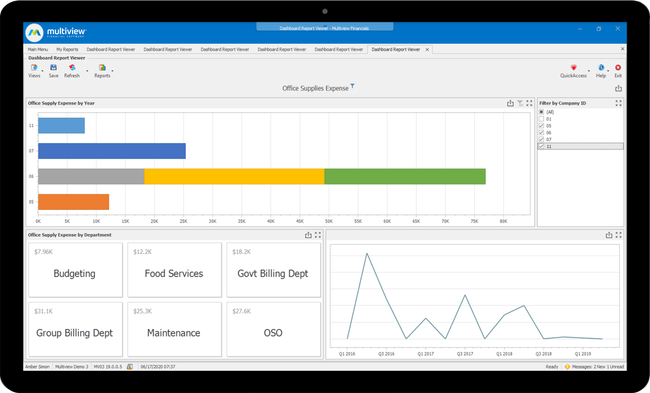
- ViewPoint tool offers strong reporting and analytics
- Scalable, user-based pricing model
- Includes 18 fully integrated modules for different industries
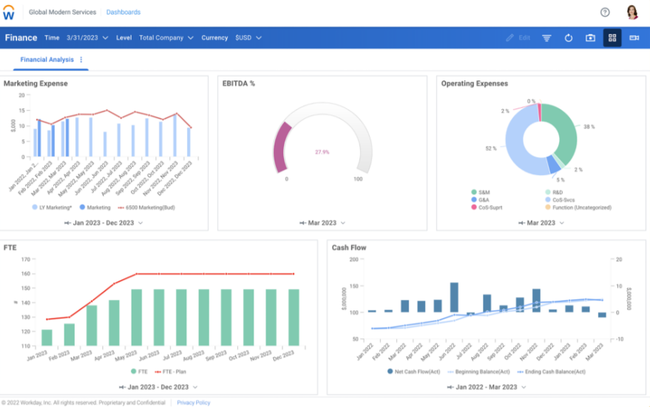
- Brainstorms from community suggestions
- Configuration flexibility
- Powerful frameworks
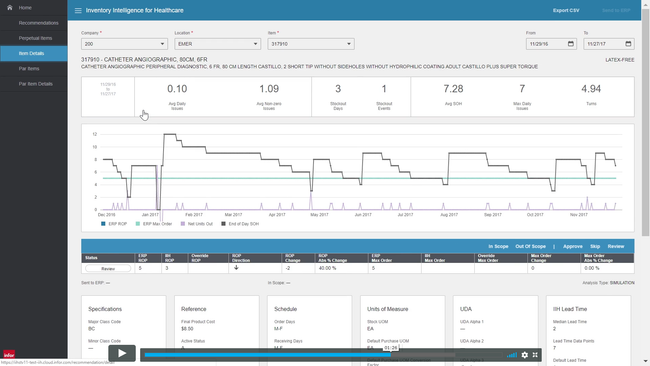
- Deep experience and use cases in the healthcare industries.
- Strong supply chain modules including mobile and point-of-care tools.
- Built in EHR integration to sync clinical, supply chain, and financial data.
In this guide, we reviewed the best systems that offer key features like patient management, telemedicine, and electronic health records.
- Multiview: Best EMR Integration
- Workday: Strong Procurement Tools
- Infor CloudSuite Healthcare: Best for Supply Chain Management
- Oracle Fusion Cloud: Best for Large Hospitals and Health Networks
- SAP Business ByDesign: Most Scalable
- NetSuite: Best for Cloud Deployment
- Dynamics 365: Best Product Ecosystem
- Acumatica: Best for Multi-Entity Support
Multiview - Best EMR Integration
Multiview has an EMR360 integration that enhances healthcare operations by connecting your organization’s financial, accounting, and EMR systems. This integration links patient data, billing, and financial records, helping improve efficiency and accuracy.
When you enter data, such as patient visits, diagnoses, treatments, and billing codes, into the EMR system, it automatically transfers this data into the accounting system for accurate invoicing and claim management. For example, if a patient comes in for a consultation, you enter their diagnosis, treatment plan, and billing information into Multiview. With the integration, as soon as the visit is completed, the patient’s details will be transferred to the financial system for invoicing. The billing department can then process a payment, and any financial adjustments will be reflected back into the patient’s medical records.
Multiview helps reduce the risk of billing errors and ensures the clinic is reimbursed quickly and accurately. The EMR360 integration can also run reports on patient revenue, track outstanding claims, and align with healthcare regulations.
Workday - Strong Procurement Tools
Workday’s supply chain management module can help streamline operations for healthcare organizations. Specifically, its AI-powered procure-to-pay software helps control costs for medical supplies. Its Illuminate AI proactively monitors supplier performance risk using real time data, ensuring you’re getting the best prices on goods from your vendors. This can really help identify areas of overspend and reduce overall procurement costs organization-wide.
You can also configure enterprise-level controls over spend. Configure detailed transaction rules that stay consistent with your organization’s best practices. You can also set role-based restrictions so only management has permission to create purchase orders or requisitions. This goes a long way for national or even global healthcare providers managing several large hospitals, as medical supply ordering can lack accountability without the right safeguards in place. Plus, the rules ensure all locations are only ordering what they need to keep costs low.
Workday is built for enterprise companies with over 2,000 employees across multiple entities. Because of its complexity and feature depth, pricing is not available publicly. That said, expect your yearly subscription costs to be over $100,000.
Infor CloudSuite Healthcare - Best for Supply Chain Management
Infor CloudSuite Healthcare offers an ERP system with a strong focus on supply chain management. It gives healthcare organizations centralized control over sourcing, procurement, inventory, and distribution. Its 24/7 visibility and automation tools help ensure critical medical supplies are available when and where they’re needed.
Its supply chain management tools replace multiple systems with a single platform that connects directly to vendors and distributors. Automated replenishment, expiration date tracking, and mobile-enabled inventory control are just a few of its tools that help prevent supply shortages and reduce waste. A new feature offered through Infor Enterprise AI adds voice-assisted inventory lookup; it allows staff to locate items easily, log that movement, and automatically update stock count to reflect the change.
Infor CloudSuite Healthcare is best suited for mid-sized to large hospitals or health networks that rely on high-volume, tightly coordinated supply chains. While its implementation can be less complex than some competing enterprise ERPs, smaller clinics or specialty providers may find it more than they need. Pricing is quote-based and reflects its enterprise scope, with full deployments often reaching into the high six-figure or seven-figure range depending on size, project scale, and selected modules.
Oracle Fusion Cloud - Best for Large Hospitals and Health Networks
Oracle Fusion Cloud is built for large, multi-facility healthcare organizations that need strong financial, supply chain, and operational visibility across health networks. Unlike lighter, mid-market systems, Oracle’s ERP suite supports high transaction volumes, multi-entity structures, and complex compliance for major hospitals.
Its enterprise financials consolidate data from every connected hospital, clinic, and specialty center into a central database, making it easier to track margins, manage budgets, and forecast overall performance. Oracle Fusion Cloud also connects with Oracle’s dedicated EHR platform (Oracle Health) for a complete platform covering back office and clinical workflows.
Its supply chain management is equally as strong. Oracle helps hospitals maintain stable inventory levels by centralizing procurement and coordinating purchasing across multiple facilities, ensuring each location receives exactly what it needs without overspending. It also tracks equipment usage, such as imaging equipment, as well as consumables like pharmaceuticals and surgical supplies, ensuring that operating rooms and surgical centers never run out of the critical resources required for patient care.
Because Oracle Fusion Cloud ERP is designed for enterprise-scale deployments, pricing is quote-based and often significantly higher compared to mid-market ERPs. Large hospital health systems can expect multi-year investments that reach into the high six figures or even seven figures, depending on the scope, number of facilities, and integration requirements. Organizations using Epic or Cerner(Oracle Health) will typically require additional configuration work and costs during implementation.
SAP Business ByDesign - Most Scalable
SAP Business ByDesign provides an integrated ERP solution that supports a wide range of business operations. For healthcare facilities, this means handling everything from basic finances down to procurement, compliance management, supplier relationship management, and HR.
The adaptability of SAP Business ByDesign is also crucial for healthcare organizations, as it allows providers the ability to respond to changing regulations. Overall, SAP Business ByDesign offers healthcare organizations a scalable, adaptable, and comprehensive ERP solution that can streamline operations and enhance the ability to deliver high-quality patient care.
NetSuite - Best for Cloud Deployment
NetSuite is Oracle’s mid-market cloud-based ERP software that offers several features and capabilities that make it suitable for healthcare organizations. NetSuite’s cloud-first nature provides healthcare professionals with access anytime and anywhere which is essential for optimizing workflows and patient care coordination for growing teams.
NetSuite’s scalability makes it a viable option for mid-sized healthcare facilities that have outgrown basic accounting solutions. Its ability to handle inventory control, time tracking, and supply chain management is particularly relevant for distribution within the healthcare sector.
While its flexibility is a major strength, NetSuite’s implementation can be complex and may require external expertise. Pricing is quote-based, and costs can rise for organizations that need advanced modules or significant customization. NetSuite is best suited for healthcare providers seeking an enterprise-grade, fully cloud-based ERP that supports growth, remote access, and real-time decision-making.
Dynamics 365 - Best Product Ecosystem
Microsoft Dynamics 365’s comprehensive suite of functionalities, including finance, human resources, and operations, makes it well-suited to address the multifaceted needs of healthcare institutions. The software’s integration capabilities with other Microsoft services like Office 365 and Power BI are particularly advantageous for healthcare facilities aiming to unify their operations and leverage familiar tools.
Dynamics 365 offers healthcare institutions the automation of recurring tasks like invoicing and reporting, streamlining administrative processes. Furthermore, the flexibility of deployment, including cloud and on-premises options, caters to the diverse IT infrastructure setups commonly found in healthcare environments.
Acumatica - Best for Multi-Entity Support
Acumatica is an ERP with open architecture, which facilitates rapid integrations, can be particularly advantageous in healthcare, where interoperability with various systems like EHR and Laboratory Information Systems (LIS) is crucial for seamless patient care and data management. Furthermore, the platform’s multi-entity support is valuable for healthcare organizations with multiple facilities, allowing for efficient global financial consolidation.
Healthcare’s complex and evolving requirements can result in the need for customizations and modules, and Acumatica’s consumption-based pricing model allows organizations to tailor the ERP precisely to their needs.
What is Healthcare ERP software?
Healthcare ERP (Enterprise Resource Planning) systems are built to optimize administrative and operational processes at hospitals, clinics, and other medical practices. They help organizations manage finance, HR, supply chain, and patient administration from a centralized platform.
Tailored for the healthcare industry, these systems go beyond general ERP functionality with tools for HIPAA compliance, complex billing cycles, medical inventory tracking, and supply chain planning. By unifying data across all departments, software helps control costs and improve coordination between clinical and administrative teams to better support employees and patients.
Key Features
ERP for the healthcare industry needs to include these key features:
-
Financial Management: Tracks revenue, expenses, and budgets with healthcare-specific tools for complex billing cycles, insurance claims processing, and revenue cycle management.
-
Supply Chain and Inventory Control: Monitors medical equipment, pharmaceuticals, and consumable supplies, helping prevent shortages and reduce overstock.
-
Human Resources and Payroll: Manages staff scheduling, payroll, credential verification, and compliance with labor laws specific to healthcare settings.
-
Patient Administration: Handles admissions, transfers, and discharges while connecting patient data across departments for smoother care coordination.
-
Regulatory Compliance: Ensures data privacy and security with HIPAA, HITECH, and other healthcare regulatory requirements.
-
Scheduling: Coordinates employee shifts, operating room availability, and patient appointments to ensure optimal staffing and resource allocation.
-
Integration with EHR/EMR Systems: Connects ERP functions with electronic health records to keep financial, administrative, and clinical data consistent and up to date.
-
Procurement and Vendor Management: Streamlines purchasing and monitors vendor performance to maintain steady medical supply levels and control costs.
-
Mobile Access: Enables staff to securely access schedules, records, and approvals from any location while meeting healthcare privacy requirements.
-
Analytics and Reporting: Provides real-time dashboards and detailed reports to track costs, monitor operations, and measure patient care performance.
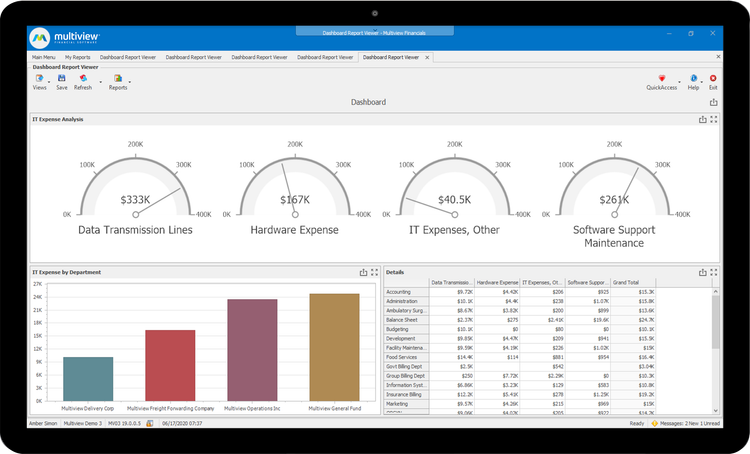
What to Look for in Healthcare ERP
Here are a few other things to consider when searching for healthcare ERP software:
- Vendor Reputation: Request customer references and case studies from the vendor to better understand how they will work for you.
- Data Security Compliance: Check whether your ERP’s data compliance meets HIPAA standards and other relevant security regulations.
- Customization: The chosen ERP system should allow for customization to adapt to specific workflows and requirements of your healthcare organization.
- User Training: Proper staff training is essential to ensure all users understand the full benefits of the ERP system.
- Scalability: Ensure that the ERP system can scale as your healthcare facility grows to accommodate increasing patients, staff, and resources.
- Total Cost of Ownership (TCO): Evaluate the total cost of ownership, including upfront costs, ongoing maintenance, and support fee to see if it fits within your long-term budget.
- Support and Maintenance: To minimize service interruptions, create an internal tech support team or contract maintenance services from the vendor.
- Integration: Assess the ERP system’s ability to integrate with existing systems and future technologies to avoid data silos and enhance interoperability. Popular integrations include clinic management and EHR software.
Healthcare ERP Benefits
Streamlined Operations
A healthcare ERP centralizes financial, HR, and supply chain workflows into a single system, replacing the chaos of siloed tools and manual processes. No more duplicate data entry or departments working with outdated information. With an ERP everyone operates from the same real-time data, leading to faster decision-making and genuinely smoother operations.
Improved Patient Care
When nurses and doctors can instantly access patient records, and scheduling staff can see where resources are needed most, everything flows smoothly. Appointment scheduling becomes automatic, delays disappear, and human errors drop dramatically. The result? Patients get the care they need without administrative friction.
Cost Savings
Healthcare ERPs attack wasteful spending from many angles. It makes purchasing strategic rather than reactive, keeps inventory at optimal levels, and helps staffing allocate employees where they are needed most. This might sound similar to the other benefits discussed, but when you streamline operations and improve patient care, you end up saving costs over the long run and help your organization run better.
Regulatory Readiness
Built-in compliance features help organizations meet HIPAA, HITECH, and other healthcare regulations. ERP systems can track employee data access, manage secure user permissions, and generate regulatory reports automatically without human intervention. This not only reduces the risk of penalties from non-compliance but also reduces the resources dedicated to staying compliant.
Better Resource Utilization
And last but not least, improved resource scheduling and asset management tools ensure staff, equipment, and facilities are used to their optimal levels. Shift leaders can monitor equipment and nurse availability and match resources to understaffed locations or floors. And purchasing departments can proactively purchase supplies in anticipation for peak time periods. This improves efficiency while maintaining a high standard of patient care.
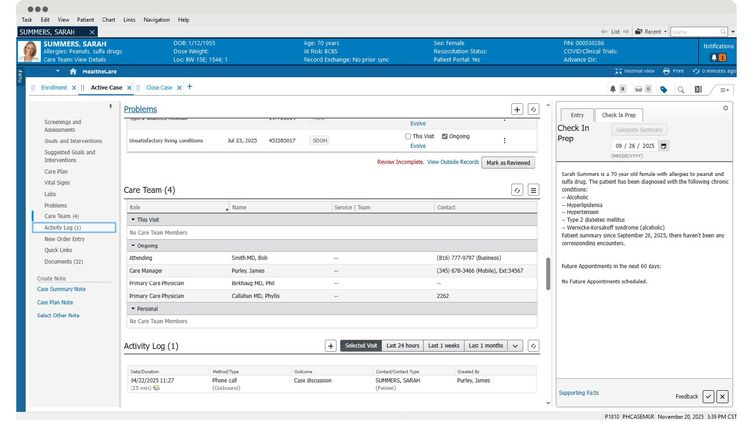
How Much Does Healthcare ERP Software Cost?
Healthcare ERP pricing typically ranges from $20,000 to $75,000 per year for small and specialty clinics, and $150,000 to over $1 million for large hospitals or multi-facility networks. Pricing typically depends on modules required, clinical integrations, and deployment scope.
| Tier | Annual Cost Range | Features You Can Expect |
|---|---|---|
| Small Clinics (1–2 locations) | $20,000–$75,000 | Core financials, HR, basic supply chain, limited reporting, minimal clinical integrations. |
| Mid-Sized Practices / Regional Providers | $75,000–$150,000 | Full financials, procurement, stronger inventory controls, basic revenue cycle tools, optional EHR integrations. |
| Hospitals (Single Facility) | $150,000–$300,000+ | Advanced supply chain, surgical and equipment tracking, full revenue cycle management, robust analytics, EHR interoperability. |
| Health Systems / Multi-Facility Networks | $300,000+ (quote-based) | Enterprise-wide integration, multi-site financial consolidation, advanced security, deep EHR connectivity, complex workflow automation. |
Implementation costs often represent the most significant portion of the overall investment and vary depending on the level of implementation assistance and customization required by the organization. Ongoing maintenance costs may also impact annual spend covering updates, regulatory changes, security improvements, and vendor support resources. For specific pricing details, a consultation with software vendors is typically required.
Want detailed quotes from leading vendors? Talk to one of our free software advisors













































